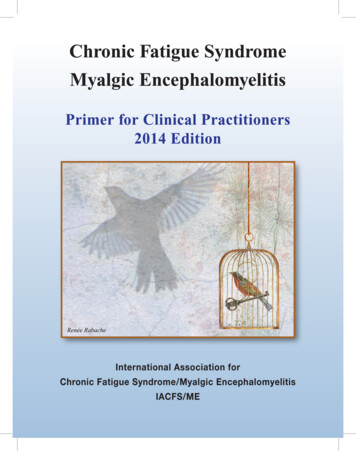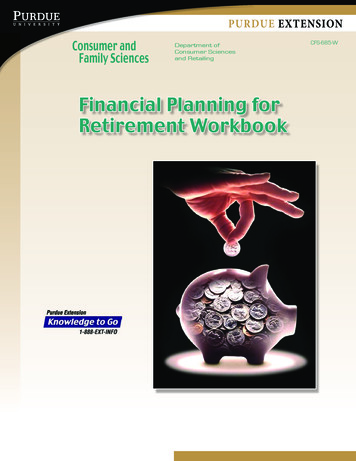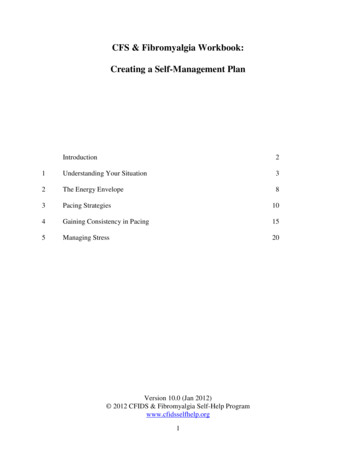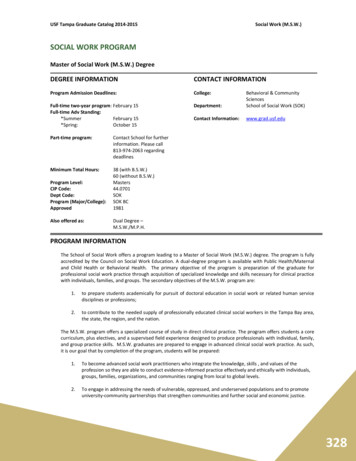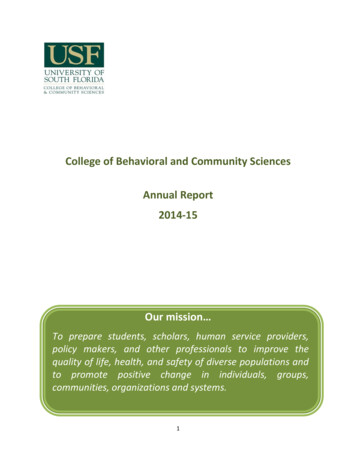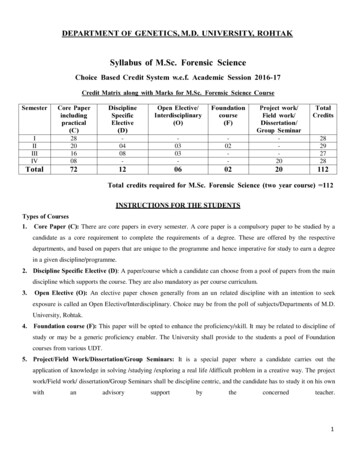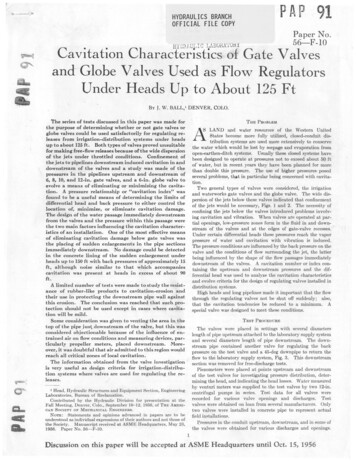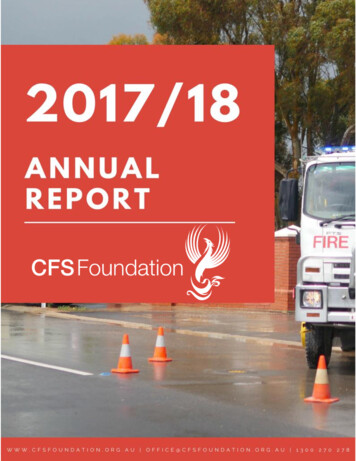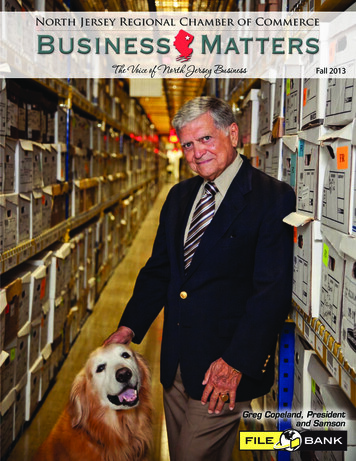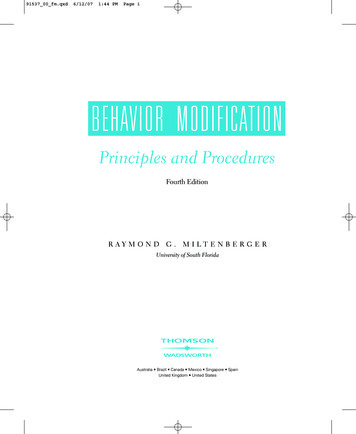
Transcription
91537 00 fm.qxd6/12/071:44 PMPage iBEHAVIOR MODIFICATIONPrinciples and ProceduresFourth EditionRAYMOND G. MILTENBERGERUniversity of South FloridaAustralia Brazil Canada Mexico Singapore SpainUnited Kingdom United States
91537 00 fm.qxd6/12/071:44 PMPage iiBehavior Modification: Principlesand Procedures, Fourth EditionRaymond G. MiltenbergerPublisher:Michele SordiEditor:Jaime A. PerkinsManaging Assistant Editor:Dan MoneypennyEditorial Assistant:Rachel GuzmanTechnology Project Manager:Bessie WeissMarketing Manager:Sara SwangardMarketing Assistant:Melanie CreggerMarketing Communications Manager:Linda YipProject Manager, EditorialProduction:Mary NoelCreative Director:Rob HugelCopy Editor:Graphic World Publishing ServicesCover Designer:Lisa DelgadoArt Director:Vernon T. BoesCover Image:Digital Art/CorbisPrint Buyer:Judy InouyePermissions Editors:Roberta Broyer, Kiely SiskProduction Service:Anne Williams, Graphic WorldPublishing ServicesCompositor:ICC Macmillan Inc.Printer:Courier Corporation/WestfordText Designer:Cheryl Carrington 2008, 2004 Thomson Wadsworth, a part of The ThomsonCorporation. Thomson, the Star logo, and Wadsworth aretrademarks used herein under license.ALL RIGHTS RESERVED. No part of this work covered bythe copyright hereon may be reproduced or used in any formor by any means—graphic, electronic, or mechanical,including photocopying, recording, taping, Web distribution,information storage and retrieval systems, or in any othermanner—without the written permission of the publisher.Printed in the United States of America1 2 3 4 5 6 7 11 10 09 08 07ExamView and ExamView Pro are registered trademarksof FSCreations, Inc. Windows is a registered trademark of theMicrosoft Corporation used herein under license. Macintoshand Power Macintosh are registered trademarks of AppleComputer, Inc. Used herein under license. 2008 Thomson Learning, Inc. All Rights Reserved.Thomson Learning WebTutor is a trademark of ThomsonLearning, Inc.Library of Congress Control Number: 2007927252ISBN-13: 978-0-495-09153-0ISBN-10: 0-495-09153-7Photo Researcher:Anne WilliamsThomson Higher Education10 Davis DriveBelmont, CA 94002-3098USAFor more information about our products, contact us at:Thomson Learning Academic Resource Center1-800-423-0563For permission to use material from this text or product,submit a request online athttp://www.thomsonrights.com.Any additional questions about permissions can besubmitted by e-mail to thomsonrights@thomson.com.
91537 00 fm.qxd6/12/071:44 PMPage iiiTo my wife, Nasrin,and my kids, Ryan, Roxanne, and Steven
91537 00 fm.qxd6/12/071:44 PMPage ivA B O U TRaymond G. Miltenberger received hisPh.D. in Clinical Psychology in 1985from Western Michigan University. He is currentlya professor and director of the Applied BehaviorAnalysis Masters Program at the University ofSouth Florida. Dr. Miltenberger conducts applied behavior analysis research with his studentsand publishes widely in the areas of habit disorders, functional assessment and treatment of behavioral disorders, and self-protection skills training. He utilizes behavior modification in clinicalwork with children and individuals with mentalretardation. In addition to spending time with hisfamily, he enjoys running, golf, baseball, andtravel.ivT H EA U T H O R
91537 00 fm.qxd6/12/071:44 PMPage vB R I E FOne / Introduction to Behavior ModificationP A R T11MEASUREMENT OF BEHAVIOR AND BEHAVIOR CHANGETwo / Observing and Recording Behavior 21Three / Graphing Behavior and Measuring ChangeP A R T2CONTENTS47BASIC PRINCIPLESFour / Reinforcement 73Five / Extinction 101Six / Punishment 119Seven / Stimulus Control: Discrimination and GeneralizationEight / Respondent Conditioning 165P A R T3143PROCEDURES TO ESTABLISH NEW BEHAVIORNine / Shaping 185Ten / Prompting and Transfer of Stimulus Control 205Eleven / Chaining 227Twelve / Behavioral Skills Training Procedures 251P A R T4PROCEDURES TO INCREASE DESIRABLE BEHAVIOR AND DECREASEUNDESIRABLE BEHAVIORThirteen / Understanding Problem Behaviors through Functional Assessment 273Fourteen / Applying Extinction 303Fifteen / Differential Reinforcement 327Sixteen / Antecedent Control Procedures 359Seventeen / Using Punishment: Time-Out and Response Cost 389Eighteen / Positive Punishment Procedures and the Ethics of Punishment 411Nineteen / Promoting Generalization 433P A R T5OTHER BEHAVIOR CHANGE PROCEDURESTwenty / Self-Management 457Twenty-One / Habit Reversal Procedures 479Twenty-Two / The Token Economy 497Twenty-Three / Behavioral Contracts 521Twenty-Four / Fear and Anxiety Reduction ProceduresTwenty-Five / Cognitive Behavior Modification 565v541
91537 00 fm.qxd6/12/071:44 PMPage viCONTENTSONEIntroduction to Behavior Modification 1DEFINING HUMAN BEHAVIOR 2EXAMPLES OF BEHAVIOR 4DEFINING BEHAVIOR MODIFICATIONChild Management 13Prevention 13Sports Psychology 13Health-Related Behaviors 13Gerontology 145CHARACTERISTICS OF BEHAVIOR MODIFICATION 5HISTORICAL ROOTS OF BEHAVIOR MODIFICATION 7Major Figures 7Early Behavior Modification Researchers 9Major Publications and Events 9AREAS OF APPLICATION 10Developmental Disabilities 10Mental Illness 11Education and Special Education 11Rehabilitation 12Community Psychology 12Clinical Psychology 12Business, Industry, and Human Services 12Self-Management 13P A R TTWO1THE STRUCTURE OF THIS TEXTBOOK 14Measurement of Behavior and BehaviorChange 14Basic Principles of Behavior 14Procedures to Establish New Behaviors 14Procedures to Increase Desirable Behaviorsand Decrease Undesirable Behaviors 15Other Behavior Change Procedures 15CHAPTER SUMMARY 15KEY TERMS 16PRACTICE TEST 16CHAPTER QUIZZES17MEASUREMENT OF BEHAVIOR AND BEHAVIOR CHANGEObserving and Recording Behavior 21DIRECT AND INDIRECT ASSESSMENT 22DEFINING THE TARGET BEHAVIOR 23THE LOGISTICS OF RECORDING 24The Observer 24When and Where to Recordvi25
91537 00 fm.qxd6/12/071:44 PMPage viiContentsCHOOSING A RECORDING METHOD 27Continuous Recording 27Percentage of Opportunities 30Product Recording 30Interval Recording 31Time Sample Recording 31CHOOSING A RECORDING INSTRUMENTREACTIVITY 36THREEINTEROBSERVER RELIABILITY 37CHAPTER SUMMARY 38KEY TERMS 38PRACTICE TEST 39APPLICATIONS 39MISAPPLICATIONS 40CHAPTER QUIZZES 4332Graphing Behavior and Measuring ChangeCOMPONENTS OF A GRAPH48Alternating-Treatments Design 59Changing-Criterion Design 62GRAPHING BEHAVIORAL DATA 51CHAPTER SUMMARY 64KEY TERMS 65PRACTICE TEST 65APPLICATIONS 66MISAPPLICATIONS 67CHAPTER QUIZZES 69GRAPHING DIFFERENT DIMENSIONSOF BEHAVIOR 52RESEARCH DESIGNS 54A-B Design 55A-B-A-B Reversal Design 56Multiple-Baseline Design 57P A R TFOUR247RBASIC PRINCIPLESReinforcement73DEFINING REINFORCEMENT 75POSITIVE AND NEGATIVE REINFORCEMENT 78Social versus Automatic Reinforcement 80ESCAPE AND AVOIDANCE BEHAVIORS 80CONDITIONED AND UNCONDITIONED REINFORCERS 82FACTORS THAT INFLUENCE THE EFFECTIVENESS OFREINFORCEMENT 83Immediacy 83Contingency 84Establishing Operations 84Individual Differences 85Magnitude 86SCHEDULES OF REINFORCEMENTFixed Ratio 88Variable Ratio 88Fixed Interval 89Variable Interval 9086vii
91537 00 fm.qxdviii6/12/071:44 PMPage viiiContentsREINFORCING DIFFERENT DIMENSIONS OF BEHAVIORCONCURRENT SCHEDULES OF REINFORCEMENT 91CHAPTER SUMMARY 92KEY TERMS 93FIVEExtinctionDEFINING EXTINCTION91101102FACTORS THAT INFLUENCE EXTINCTIONCHAPTER SUMMARY 112EXTINCTION BURST 104SPONTANEOUS RECOVERY 106PROCEDURAL VARIATIONS OF EXTINCTION107A COMMON MISCONCEPTION ABOUTEXTINCTION 109SIX110KEY TERMS 112PRACTICE TEST 112APPENDIX A 112CHAPTER QUIZZES 115Punishment 119DEFINING PUNISHMENT 119A COMMON MISCONCEPTION ABOUT PUNISHMENT 122POSITIVE AND NEGATIVE PUNISHMENT 122UNCONDITIONED AND CONDITIONED PUNISHERS 127CONTRASTING REINFORCEMENTAND PUNISHMENT 128FACTORS THAT INFLUENCE THE EFFECTIVENESS OFPUNISHMENT 130Immediacy 131Contingency 131Establishing Operations 131Individual Differences and Magnitudeof the Punisher 132SEVENPRACTICE TEST 93APPENDIX A 94APPENDIX B 95CHAPTER QUIZZES 97PROBLEMS WITH PUNISHMENT 133Emotional Reactions to PunishmentEscape and Avoidance 134Negative Reinforcement for the Useof Punishment 134Punishment and Modeling 134Ethical Issues 135CHAPTER SUMMARY 135KEY TERMS 136PRACTICE TEST 136APPENDIX A 137CHAPTER QUIZZES139Stimulus Control: Discrimination and GeneralizationEXAMPLES OF STIMULUS CONTROL 144DEFINING STIMULUS CONTROL 144133DEVELOPING STIMULUS CONTROL: STIMULUSDISCRIMINATION TRAINING 146143
91537 00 fm.qxd6/12/071:44 PMPage ixContentsDiscrimination Training in theLaboratory 147Developing Reading and Spelling withDiscrimination Training 148Stimulus Discrimination Training andPunishment 149THE THREE-TERM CONTINGENCY 149STIMULUS CONTROL RESEARCH 150EIGHTNINE3CHAPTER SUMMARY 157KEY TERMS 157PRACTICE TEST 157APPENDIX A 158CHAPTER QUIZZES161Contingency between the ConditionedStimulus and UnconditionedStimulus 175The Number of Pairings 175Previous Exposure to the ConditionedStimulus 176DISTINGUISHING BETWEEN OPERANT AND RESPONDENTCONDITIONING 176RESPONDENT CONDITIONING AND BEHAVIORMODIFICATION 179CHAPTER SUMMARY 179KEY TERMS 180PRACTICE TEST 180CHAPTER QUIZZES 181PROCEDURES TO ESTABLISH NEW BEHAVIORShaping185AN EXAMPLE OF SHAPING: TEACHING A CHILD185TO TALK152Respondent Conditioning 165EXAMPLES OF RESPONDENT CONDITIONING 165DEFINING RESPONDENT CONDITIONING 166TIMING OF THE NEUTRAL STIMULUS AND UNCONDITIONEDSTIMULUS 169HIGHER-ORDER CONDITIONING 170CONDITIONED EMOTIONAL RESPONSES 171EXTINCTION OF CONDITIONED RESPONSES 173Spontaneous Recovery 173DISCRIMINATION AND GENERALIZATION OF RESPONDENTBEHAVIOR 174FACTORS THAT INFLUENCE RESPONDENTCONDITIONING 174The Nature of the Unconditioned Stimulusand Conditioned Stimulus 175The Temporal Relationship between theConditioned Stimulus and UnconditionedStimulus 175P A R TGENERALIZATION 151Examples of GeneralizationDEFINING SHAPING 186APPLICATIONS OF SHAPING 188ix
91537 00 fm.qxdx6/12/071:44 PMPage xContentsGetting Mrs. F to Walk Again 188Getting Mrs. S to Increase the Time betweenBathroom Visits 189RESEARCH ON SHAPING 189HOW TO USE SHAPING 194SHAPING OF PROBLEM BEHAVIORSTEN196Prompting and Transfer of Stimulus ControlAN EXAMPLE OF PROMPTING AND FADING: TEACHINGLITTLE LEAGUERS TO HIT THE BALL 205WHAT IS PROMPTING? 207WHAT IS FADING? 208TYPES OF PROMPTS 210Response Prompts 210Stimulus Prompts 211TRANSFER OF STIMULUS CONTROL 213Prompt Fading 213Prompt Delay 215Stimulus Fading 216ELEVENCHAPTER SUMMARY 198KEY TERMS 199PRACTICE TEST 199APPLICATIONS 199MISAPPLICATIONS 200CHAPTER QUIZZES 201Chaining205HOW TO USE PROMPTING AND TRANSFER OF STIMULUSCONTROL 218CHAPTER SUMMARY 220KEY TERMS 221PRACTICE TEST 221APPLICATIONS 222MISAPPLICATIONS 222CHAPTER QUIZZES 223227EXAMPLES OF BEHAVIORAL CHAINS 227ANALYZING STIMULUS-RESPONSE CHAINS 228TASK ANALYSIS 229BACKWARD CHAINING 232FORWARD CHAINING 234TOTAL TASK PRESENTATION 236OTHER STRATEGIES OF TEACHING BEHAVIORALCHAINS 238Written Task Analysis 240Picture Prompts 240Self-Instructions 241HOW TO USE CHAINING PROCEDURES 243CHAPTER SUMMARY 244KEY TERMS 244PRACTICE TEST 244APPLICATIONS 245MISAPPLICATIONS 245CHAPTER QUIZZES 247
91537 00 fm.qxd6/12/071:44 PMPage xiContentsTWELVEBehavioral Skills Training ProceduresEXAMPLES OF BEHAVIORAL SKILLS TRAININGPROCEDURES 251Teaching Marcia to Say “No” to theProfessors 251Teaching Children to Protect Themselves fromAbduction 252COMPONENTS OF THE BEHAVIORAL SKILLS TRAININGPROCEDURE 252Modeling 252Instructions 255Rehearsal 256Feedback 256ENHANCING GENERALIZATION AFTER BEHAVIORAL SKILLSTRAINING 257P A R T4THIRTEEN251IN SITU TRAINING 258BEHAVIORAL SKILLS TRAINING AND THE THREE-TERMCONTINGENCY 259BEHAVIORAL SKILLS TRAINING IN GROUPS 259APPLICATIONS OF BEHAVIORAL SKILLS TRAININGPROCEDURES 260HOW TO USE BEHAVIORAL SKILLS TRAININGPROCEDURES 264CHAPTER SUMMARY 265KEY TERMS 266PRACTICE TEST 266APPLICATIONS 267MISAPPLICATIONS 267CHAPTER QUIZZES 269PROCEDURES TO INCREASE DESIRABLE BEHAVIOR AND DECREASEUNDESIRABLE BEHAVIORUnderstanding Problem Behaviors through FunctionalAssessment 273EXAMPLES OF FUNCTIONAL ASSESSMENT 273Jacob 273Anna 275DEFINING FUNCTIONAL ASSESSMENT 276FUNCTIONS OF PROBLEM BEHAVIORS 277Social Positive Reinforcement 277Social Negative Reinforcement 277Automatic Positive Reinforcement 278Automatic Negative Reinforcement 278FUNCTIONAL ASSESSMENT METHODS 278Indirect Methods 278Direct Observation Methods 280Experimental Methods (FunctionalAnalysis) 286FUNCTIONAL ANALYSIS RESEARCH289CONDUCTING A FUNCTIONAL ASSESSMENTCHAPTER SUMMARY 294KEY TERMS 295PRACTICE TEST 295APPLICATIONS 295MISAPPLICATIONS 298CHAPTER QUIZZES299292xi
91537 00 fm.qxdxii6/12/071:44 PMPage xiiContentsFOURTEENApplying ExtinctionTHE CASE OF WILLY 303USING EXTINCTION TO DECREASE A PROBLEMBEHAVIOR 306Collecting Data to Assess TreatmentEffects 306Identifying the Reinforcer for the ProblemBehavior through FunctionalAssessment 307Eliminating the Reinforcer after EachInstance of the Problem Behavior 307TAKING ACCOUNT OF THE SCHEDULE OF REINFORCEMENT313BEFORE EXTINCTIONFIFTEENREINFORCING ALTERNATIVE BEHAVIORS 315PROMOTING GENERALIZATION AND MAINTENANCE 315RESEARCH EVALUATING THE USE OF EXTINCTION 316CHAPTER SUMMARY 319KEY TERMS 320PRACTICE TEST 320APPLICATIONS 320MISAPPLICATIONS 321APPENDIX A 322APPENDIX B 322CHAPTER QUIZZES 323Differential ReinforcementDIFFERENTIAL REINFORCEMENT OF ALTERNATIVEBEHAVIOR 327Getting Mrs. Williams to Be Positive 327When to Use DRA 329How to Use DRA 330Using Differential Negative Reinforcementof Alternative Behaviors 332Variations of DRA 334Research on DRA 335DIFFERENTIAL REINFORCEMENT OF OTHERBEHAVIOR 338Defining DRO 339Research Evaluating DRO Procedures 341SIXTEEN303327DIFFERENTIAL REINFORCEMENT OF LOW RATESOF RESPONDING 344Defining DRL 345Variations of DRL 345Implementing DRL Procedures 346Research Evaluating DRL ProceduresCHAPTER SUMMARY 350KEY TERMS 351PRACTICE TEST 351APPLICATIONS 352MISAPPLICATIONS 352CHAPTER QUIZZESAntecedent Control ProceduresEXAMPLES OF ANTECEDENT CONTROL 359Getting Marianne to Study More 359Getting Cal to Eat Right 360348355359DEFINING ANTECEDENT CONTROL PROCEDURES 361Presenting the Discriminative Stimulus (SD)or Cues for the Desired Behavior 361
91537 00 fm.qxd6/12/071:44 PMPage xiiiContentsArranging Establishing Operations for theDesirable Behavior 363Decreasing Response Effort for the DesirableBehavior 364Removing the Discriminative Stimulus orCues for Undesirable Behaviors 366Removing Establishing Operations forUndesirable Behaviors 367Increasing the Response Effort for UndesirableBehaviors 368RESEARCH ON ANTECEDENT CONTROL STRATEGIES 369Manipulating Discriminative Stimuli 370Manipulating Response Effort 372Manipulating Establishing Operations 374SEVENTEENEIGHTEENUSING ANTECEDENT CONTROL STRATEGIES 377Analysis of the Three-Term Contingency forthe Desirable Behavior 378Analysis of the Three-Term Contingency forthe Undesirable Behavior 379Functional, Nonaversive Interventionsfor Problem Behaviors 379CHAPTER SUMMARY 380KEY TERMS 380PRACTICE TEST 380APPLICATIONS 381MISAPPLICATIONS 382CHAPTER QUIZZES385Using Punishment: Time-out and Response CostTIME-OUT 390Types of Time-out 392Using Reinforcement with Time-out 392Considerations in Using Time-out 393Research Evaluating Time-out Procedures 396RESPONSE COST 399Defining Response Cost 399Using Differential Reinforcement withResponse Cost 400Comparing Response Cost, Time-out, andExtinction 400389Considerations in Using ResponseCost 401Research Evaluating Response CostProcedures 402CHAPTER SUMMARY 404KEY TERMS 404PRACTICE TEST 405APPLICATIONS 405MISAPPLICATIONS 406CHAPTER QUIZZES407Positive Punishment Procedures and the Ethicsof Punishment 411APPLICATION OF AVERSIVE ACTIVITIESOvercorrection 413Contingent Exercise 414Guided Compliance 415411xiiiPhysical Restraint 417Cautions in the Application of AversiveActivities 418APPLICATION OF AVERSIVE STIMULATION418
91537 00 fm.qxdxiv6/12/071:44 PMPage xivContentsPOSITIVE PUNISHMENT: TREATMENT OF LAST RESORT 421CONSIDERATIONS IN USING POSITIVE PUNISHMENT 422THE ETHICS OF PUNISHMENT 423Peer Review 424Accountability: Preventing Misuseand Overuse 424CHAPTER SUMMARY 425Informed Consent 423Alternative Treatments 423Recipient Safety 424Problem Severity 424Implementation Guidelines 424Training and Supervision 424NINETEENKEY TERMS 425PRACTICE TEST 426APPLICATIONS 426MISAPPLICATIONS 427CHAPTER QUIZZESPromoting Generalization 433EXAMPLES OF GENERALIZATION PROGRAMMING 433DEFINING GENERALIZATION 434STRATEGIES FOR PROMOTING GENERALIZATION OF BEHAVIORCHANGE 435Reinforcing Occurrences of Generalization 435Training Skills That Contact NaturalContingencies of Reinforcement 436Modifying Natural Contingencies ofReinforcement and Punishment 437Incorporating a Variety of Relevant StimulusSituations in Training 439Incorporating Common Stimuli 442Teaching a Range of Functionally EquivalentResponses 442P A R T5TWENTY429Incorporating Self-Generated Mediatorsof Generalization 443IMPLEMENTING STRATEGIES TO PROMOTEGENERALIZATION 445PROMOTING GENERALIZED REDUCTIONS IN PROBLEMBEHAVIORS 446CHAPTER SUMMARY 448KEY TERMS 448PRACTICE TEST 448APPLICATIONS 449MISAPPLICATIONS 450CHAPTER QUIZZES453OTHER BEHAVIOR CHANGE PROCEDURESSelf-ManagementEXAMPLES OF SELF-MANAGEMENT 457Getting Murray to Run Regularly457457Getting Annette to Clean up Her MessDEFINING SELF-MANAGEMENT PROBLEMS 459459
91537 00 fm.qxd6/12/071:44 PMPage xvContentsDEFINING SELF-MANAGEMENT 461TYPES OF SELF-MANAGEMENT STRATEGIES 462Goal-Setting and Self-Monitoring 462Antecedent Manipulations 463Behavioral Contracting 464Arranging Reinforcers and Punishers 464Social Support 465Self-Instructions and Self-Praise 466TWENTY-ONEKEY TERMS 471PRACTICE TEST 471APPLICATIONS 472MISAPPLICATIONS 472CHAPTER QUIZZESDEFINING A TOKEN ECONOMY 498IMPLEMENTING A TOKEN ECONOMY 500Defining the Target Behaviors 500Identifying the Items to Use as Tokens 500Identifying Backup Reinforcers 501Deciding on the Appropriate Schedule ofReinforcement 502Establishing the Token ExchangeRate 503Establishing the Time and Place forExchanging Tokens 503475479WHY DO HABIT REVERSAL PROCEDURES WORK? 486OTHER TREATMENT PROCEDURES FOR HABITDISORDERS 488CHAPTER SUMMARY 490KEY TERMS 491PRACTICE TEST 491APPLICATIONS 491MISAPPLICATIONS 492CHAPTER QUIZZESThe Token EconomyREHABILITATING SAMMY 497467CHAPTER SUMMARY 470Habit Reversal ProceduresEXAMPLES OF HABIT BEHAVIORS 479DEFINING HABIT BEHAVIORS 480Nervous Habits 480Motor and Vocal Tics 481Stuttering 482HABIT REVERSAL PROCEDURES 482APPLICATIONS OF HABIT REVERSAL 483Nervous Habits 483Motor and Vocal Tics 484Stuttering 486TWENTY-TWOSTEPS IN A SELF-MANAGEMENT PLANxv493497Deciding Whether to Use Response CostStaff Training and Management 505PRACTICAL CONSIDERATIONS 505APPLICATIONS OF A TOKEN ECONOMY 507ADVANTAGES AND DISADVANTAGES OF A TOKENECONOMY 510CHAPTER SUMMARY 513KEY TERMS 514PRACTICE TEST 514APPLICATIONS 514MISAPPLICATIONS 515CHAPTER QUIZZES 517504
91537 00 fm.qxdxvi6/12/071:44 PMPage xviContentsTWENTY-THREEBehavioral ContractsEXAMPLES OF BEHAVIORAL CONTRACTING 521Getting Steve to Complete HisDissertation 521Helping Dan and His Parents Get AlongBetter 523DEFINING THE BEHAVIORAL CONTRACT523COMPONENTS OF A BEHAVIORAL CONTRACTTYPES OF BEHAVIORAL CONTRACTS524526One-Party Contracts 527Two-Party Contracts 527TWENTY-FOURNEGOTIATING A BEHAVIORAL CONTRACT 529WHY DO BEHAVIORAL CONTRACTS INFLUENCEBEHAVIOR? 529APPLICATIONS OF BEHAVIORAL CONTRACTS 531CHAPTER SUMMARY 534KEY TERMS 534PRACTICE TEST 534APPLICATIONS 535MISAPPLICATIONS 535CHAPTER QUIZZES 537Fear and Anxiety Reduction ProceduresEXAMPLES OF FEAR AND ANXIETY REDUCTION 541Overcoming Trisha’s Fear of PublicSpeaking 541Overcoming Allision’s Fear ofSpiders 542DEFINING FEAR AND ANXIETY PROBLEMS 543PROCEDURES TO REDUCE FEAR AND ANXIETY 546Relaxation Training 546Systemic Desensitization 551In Vivo Desensitization 554TWENTY-FIVE521541Advantages and Disadvantages of Systematicand In Vivo Desensitization 555Other Treatments for Fears 557CLINICAL PROBLEMS 558CHAPTER SUMMARY 558KEY TERMS 558PRACTICE TEST 559APPLICATIONS 559MISAPPLICATIONS 560CHAPTER QUIZZES 561Cognitive Behavior Modification 565EXAMPLES OF COGNITIVE BEHAVIOR MODIFICATION 565Helping Deon Control His Anger 565Helping Claire Pay Attention in Class 567DEFINING COGNITIVE BEHAVIOR MODIFICATION 568Defining Cognitive Behavior 568Functions of Cognitive Behavior 569COGNITIVE BEHAVIOR MODIFICATIONPROCEDURES 570Cognitive Restructuring 570Cognitive Coping Skills Training 574Acceptance-Based Therapies 577CLINICAL PROBLEMS 578
91537 00 fm.qxd6/12/071:44 PMPage xviiContentsCHAPTER SUMMARY 578KEY TERMS 578PRACTICE TEST 578GLOSSARY 585REFERENCES 597CREDITS 623NAME INDEX 625SUBJECT INDEX 631APPLICATIONS 579MISAPPLICATIONS 579CHAPTER QUIZZES 581xvii
91537 00 fm.qxd6/12/071:44 PMPage xviiiPREFACEWe are gratified that the first three editionsof Behavior Modification: Principles andProcedures received positive reviews from students and professors. The fourth edition has keptthe positive features of the first three editions, andhas been revised to address the suggestions of reviewers and updated to reflect the latest researchin behavior modification.The goal of this fourth edition (as with theearlier editions) is to describe basic principles ofbehavior, so that the student learns how environmental events influence human behavior, andto describe behavior modification procedures, sothat the student learns the strategies by whichhuman behavior may be changed. The text isdivided into 25 relatively short chapters, each ofwhich covers a manageable amount of information (for example, one principle or procedure).This text can be used in a standard one-semestercourse in behavior modification, applied behavior analysis, behavior management, or behaviorchange.The material in the text is discussed at anintroductory level, so that it may be understoodby students with no prior knowledge of the subject. This text is intended for undergraduate students or beginning graduate students. It wouldalso be valuable for individuals working inhuman services, education, or rehabilitationwho must use behavior modification proceduresto manage the behavior of the individuals intheir care.I have made a concerted effort in this text tobe gender neutral. When discussing case examples, I include males and females about equallyas often.F E AT U R E S O F T H E T E X T C O N T I N U E D F R O MTHE FIRST THREE EDITIONSable behaviors are considered in Chapters 13–19.Finally, Chapters 20–25 present a survey of otherimportant behavior modification procedures.The following features of the text are intended tohelp the reader learn easily.Organization of the TextPrinciples and ProceduresFollowing a general introduction to the field inChapter 1, Chapters 2 and 3 present informationon behavior recording, graphing, and measuringchange. This information will be utilized in eachsubsequent chapter. Next, Chapters 4–8 focus onthe basic principles of operant and respondentbehavior. The application of these principlesforms the subject of the remaining 17 chapters.Procedures to establish new behaviors are described in Chapters 9–12, and procedures to increase desirable behaviors and decrease undesir-The various procedures for changing behaviorare based on fundamental principles of behaviorestablished in experimental research over the last70 years. In the belief that the student will betterunderstand the procedures after first learning thefundamental principles, the principles underlying operant and respondent behavior are reviewed in Chapters 4–8; the application of theprinciples in the behavior modification procedures is described in Chapters 9–25.xviii
91537 00 fm.qxd6/12/071:44 PMPage xixPrefaceExamples from Everyday LifeEach chapter uses a variety of real-life examples—some relevant to college students, some chosenfrom the author’s clinical experience—to bringthe principles and procedures to life.Examples from ResearchIn addition, both classic studies and the most upto-date research on behavior modification principles and procedures are integrated into the text.Quizzes Accompany Each ChapterAt the end of each chapter are three fill-inthe-blank quizzes with 10 questions each. Thequizzes provide students with further exercises forself-assessment of their knowledge of the chapter’s content. The quizzes are on perforatedpages, which can be easily torn out so that the instructor can have students hand the quizzes in ashomework assignments or have students take thequizzes in class.xixthe application of the procedure in that case.These misapplication exercises require the student to think critically about the application ofthe procedure. Answers to Applications and Misapplications are in the Instructors Manual, making them valuable tools for instructors as theyassess their students’ abilities to apply the information provided in the chapter.Step-by-Step ApproachIn each chapter in which a particular behaviormodification procedure is taught, the implementation of the procedure is outlined in a step-bystep fashion, for ease of comprehension.Summary BoxesPeriodically throughout the text, informationfrom a chapter is summarized in a box that hasbeen set off from the text. These boxes are intended to help the student organize the materialin the chapter.Practice TestsChapter SummariesPractice tests at the end of each chapter haveshort-answer essay questions, complete with pagenumbers where the answers can be found.Chapter summaries provide information that isconsistent with the opening questions in eachchapter.Application ExercisesExamples for Self-AssessmentAt the end of each chapter where procedures aretaught (Chapters 2, 3, and 9–25), several application exercises are provided. In each exercise, areal-life case is described and then the student isasked to apply the procedure described in thechapter. These exercises give students an opportunity to think about how the procedures are applied in real life.In the early chapters on basic principles (Chapters 4–7) there are tables with examples of theprinciple discussed within that chapter. Later inthe chapter (or in a subsequent chapter), the student is directed to return to a specific table and,using the new information being presented in thechapter, to analyze specific aspects of the examples provided in that table.Misapplication ExercisesSelf-Assessment QuestionsThe application exercises are followed by misapplication exercises. In each one, a case example isprovided, and the procedure from the chapter isapplied to the case in an incorrect or inappropriate manner. The student is asked to analyze thecase example and to describe what is wrong withAt intervals throughout the text, students are presented with self-assessment questions. To answerthese questions, students will need to utilize theinformation already presented in the chapter.These questions will help students assess theirunderstanding of the material. In most cases,
91537 00 fm.qxdxx6/12/071:44 PMPage xxPrefaceanswers are presented in the text immediately following the question.FiguresMost of the chapters include figures from the research literature to illustrate important principlesor procedures. Students must use informationfrom earlier chapters on behavior recording,graphing, and measuring change to analyze thegraphs.N E W F E AT U R E SIN THEGlossaryAt the end of the text is a glossary of the importantbehavior modification terms used in the text.Each term is followed by a succinct and precisedefinition.Improved Test BankThe test bank includes multiple-choice questions, fill-in-the-blank questions, true-false questions, and short-answer essay questions.FOURTH EDITIONIn addition to the features continued from thefirst three editions, three major features havebeen added to the fourth edition.the terms when reading the chapter or whenstudying for a test or quiz.Updated and Expanded ReferencesFor Further ReadingIn each of the chapters on behavioral principles(Chapters 4–8) and procedures (Chapters 9–25)a For Further Reading box has been added. Inthis feature, interesting articles that are relevantto the content of the chapter are identified andbriefly described. Citations for these articles havealso been provided. These articles are from JABA(or JEAB), so they can be easily accessed onlineby students. (The JABA website is http://seab.envmed.rochester.edu/jaba/.) Instructors can assign these articles for extra credit or as readingassignments for when more advanced studentsuse the textbook.List of Key TermsAfter each Chapter Summary section, there isnow a list of the new terms that were used in thechapter. The list of key terms shows the pagenumber on which each term was introduced. Although these terms are all found in the Glossaryat the end of the text, having the new terms listedat the end of each chapter with page numberswill allow the student to make easy reference toThe fourth edition includes 125 additionalreferences—many of which are from the mostrecent volumes of JABA—to present studentswith the most recent scholarship in the field.Other New FeaturesChapter 1 has a brief discussion of the relationship between applied behavior analysis and behavior modification. Chapter 2 has new information on structured versus unstructured assessmentand on recording percentage of opportunities.Chapter 4 has an added discussion of social versusautomatic reinforcement. Chapter 7 has a newfigure from Lalli et al. (1998), showing another example of a generalization gradient relevant to anapplied problem. Chapter 12 has a new sectionon in situ training, a method used to increase generalization following the use of behavioral skillstraining. New chapter headings are provided tohelp the reader better organize the research onantecedent control in Chapter 16. In Chapter 19,one figure was eliminated (Figure 19.2 fromAyllon, Kuhlman, & Warzak, 1982), and anotherfigure and text was added (Durand, 1999) to highlight a study on programming generalization.
91537 00 fm.qxd6/12/071:44 PMPage xxiPrefacexxiACKNOWLEDGMENTSI want to thank the anonymous reviewer
Principles and Procedures Fourth Edition RAYMOND G. MILTENBERGER University of South Florida BEHAVIOR MODIFICATION 91537_00_fm.qxd 6/12/07 1:44 PM Page i. Behavior Modification: Principles and Procedures, Fourth Edition
